There is nothing more classic than a pair of jeans. Quite possibly the most versatile pants in your closet – jeans are beloved by all. They are comfortable and cute, and there’s a great pair for everyone. Jeans have the power to make us look and feel amazing – so it’s important to know how jeans should fit.
Jeans that fit perfectly should always be comfortable. They should fit snugly around the waist but should never be so tight that you feel uncomfortable pressure at any point on the body. Depending on the style – the length of a pair of jeans should hit anywhere from mid-calf to slightly below the ankle.
In this article, we will go over everything you need to know about how jeans should fit – from waist to length. We will also cover what components contribute to how jeans fit and how you can find the most flattering pair.
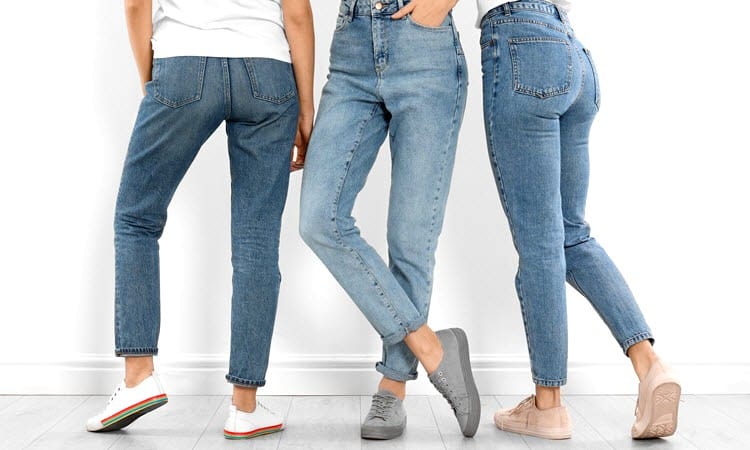
Quick Navigation
- How Should Jeans Fit
- Where Should Jeans Sit on Shoes?
- How Long Should Jeans Be Without Shoes?
- How to Tell If Your Jeans Fit Correctly
- How Long Should Jeans Be?
- Other Jean Styles and Trends
- How to Find Flattering Jeans
- Find a Fit for Your Body Type
- Is it Better to Size Up or Down When Buying Jeans?
- How Should Men’s Jeans Fit?
- Conclusion
How Should Jeans Fit
When you think of a great pair of jeans, you can imagine a pair of pants that feels like it’s one with your body. A pair of pants that you’ll want to put on every morning. When trying to put together an outfit, your favorite jeans will often be what you end up wearing – even if you’ve tried on several other items first. The most important factor when determining if your jeans fit correctly is their comfort. Above all other things – jeans should feel great to wear.
There are several contributing factors when it comes to finding the perfect fit. What may feel like the perfect fit to one could easily not suit the person standing next to them. The waist and length of the jeans are the most obvious place to start when looking for fit-in jeans. Then there is the style to account for as well.
One cut of jeans may fit the same person completely differently than an alternative style. In addition to all of this, consider that no two bodies are alike. This should make it obvious why finding the perfect pair of jeans isn’t quite as simple as it should be and stress the importance of trying on different pairs.
Waist
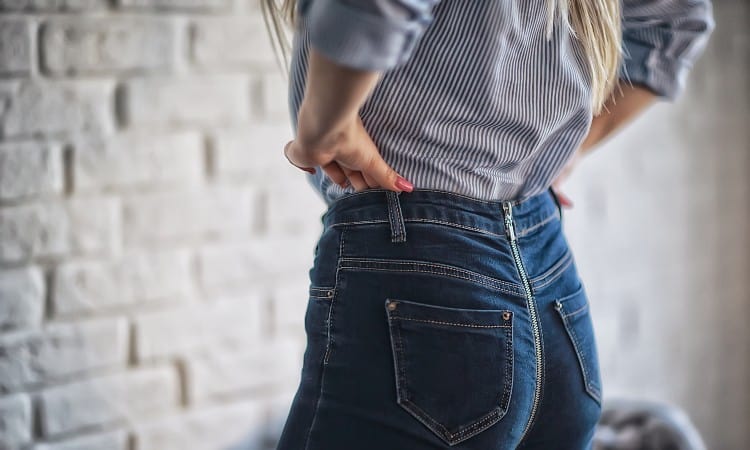
The waist is possibly the most important area where fit is crucial. Jeans should fit snug but not be too tight. A good rule of thumb is that you should be able to fit two fingers into the waistline with relative ease. It should never feel like your pants are squeezing the life out of you. It shouldn’t be difficult to breathe, and of course – you should be able to move and sit comfortably.
On the other hand – you shouldn’t have to pull your jeans up every few steps when walking down the street either. It’s important to find the perfect balance. For regular fit jeans – neither low nor high rise – the waistline should fall naturally 1” to 2” below the belly button.
High-rise jeans shouldn’t come up as far as your rib cage. And if you opt for the low rise – your belly should never be hanging over the waist of the jeans. Jeans should also fit snugly around the hips without feeling super tight.
Length
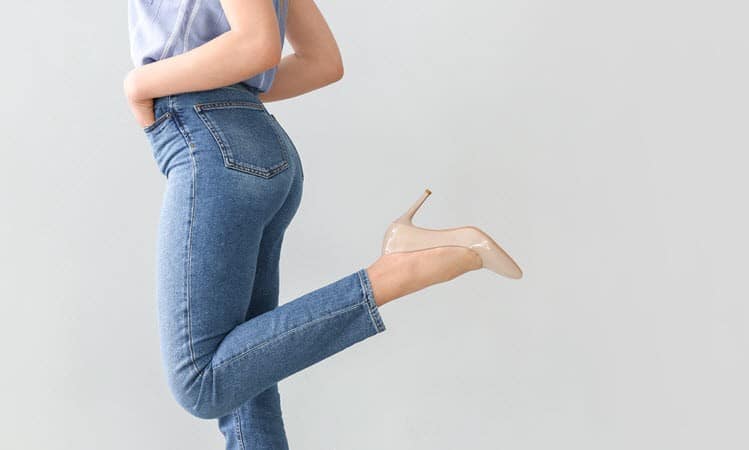
The perfect length for jeans is important as well. The entire look can change depending on how long the pair of pants is. This, though, can be a bit more difficult to pin down – since jeans come in so many different styles.
The inseam is a good determining factor when considering any standard full-length cuts. The inseam measures from the crotch to the bottom of the leg opening along the inside seam of the pants.
The easiest way to determine your inseam is to measure that of a pair of pants you know fit well. Inseam lengths for jeans are often indicated on tags/item descriptions – so having this information will be helpful when shopping for the right length.
At the Ankle
Most regular-length styles of jeans should fall right around the ankle or just below. Cuts that should fall at the ankle include bootcut, straight and wide-leg styles. There is a small amount of leeway in either direction, of course, the leg shape will also be a factor here. But if you go much shorter than the ankle in these styles, you may risk looking like the pants are too small.
When Sitting
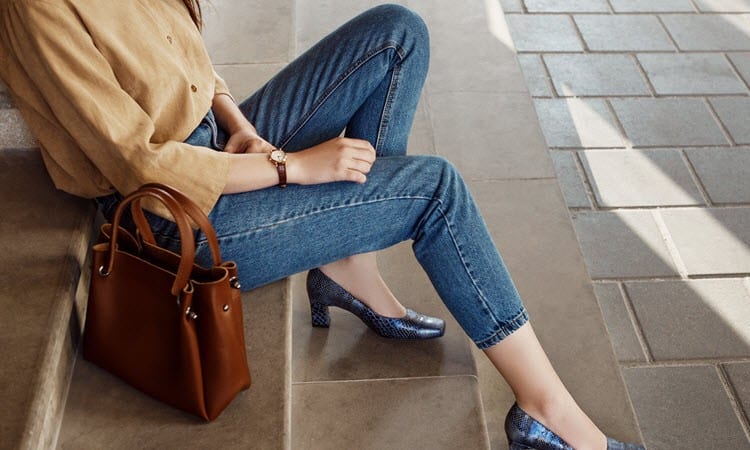
A sit test is always a good idea when trying a new pair of jeans. You should be able to sit down comfortably without an increased amount of pressure. If it ever feels like you need to unbutton the fly to be comfortable – that’s a sure sign that the pants are too small.
The length of the jeans will ride up slightly when seated. For full-length jeans, they may just brush the tops of your shoes or be just slightly above the front. In the back, they should come to some point mid-heel.
Where Should Jeans Sit on Shoes?
The bottom of your jeans should meet the tops of your shoes. There should be a slight break in the hem and there should be a small amount of additional length that should be about an inch above the floor. Classically – socks or ankles should be completely covered by the pant leg when standing and only be slightly exposed when seated. Of course – this isn’t always the case when considering alternate cuts such as capris or cropped jeans.
How Long Should Jeans Be Without Shoes?
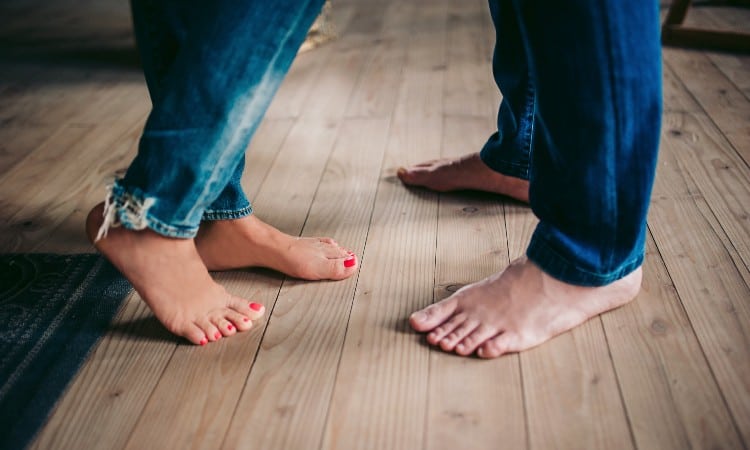
For full-length jeans – the correct length when worn without shoes will have the bottom of the hem reaching the floor. This should put the jeans at about an inch from the floor – which is the correct length – when worn with a flat pair of shoes. If there is extra length – depending on the style of the jeans – you can always consider folding a cuff to bring them to the correct point.
How to Tell If Your Jeans Fit Correctly
The biggest factor in determining whether or not your jeans fit correctly is their comfortability. With so many cuts and personalized styles, it’s often more difficult than not to get things wrong – as long as the jeans feel good. That being said – everyone wants their jeans to be flattering. Some standards can be considered beyond the pants squeezing your belly or having them fall down your legs.
Leg Shape
The shape of the leg is largely what makes the difference between styles of jeans. When we hear of skinny, slim, tapered or bootcut, these names reference the jeans’ leg shape. Each different style has nuances to how they were designed to be worn.
Skinny or tapered leg jeans are meant to be worn slightly above the ankle. Bootcut is to be worn at the ankle bone. And straight leg jeans should lie just below the ankle. This is all, give or take and should ultimately come down to what feels perfectly right to you.
Rise
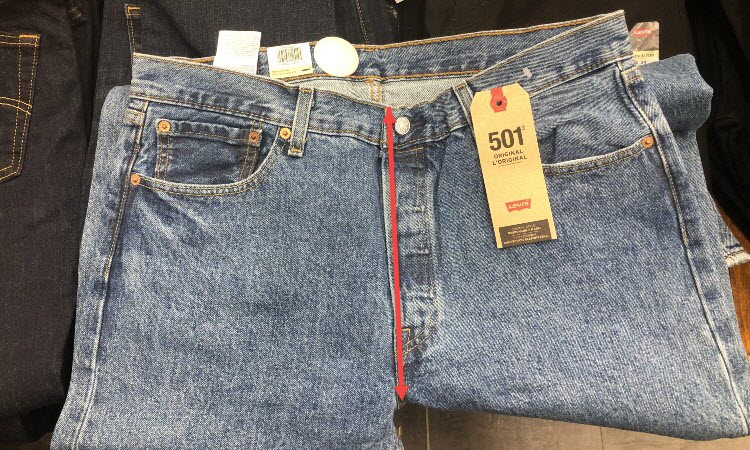
The rise of the jeans is measured from the bottom of the crotch up to the top of the waistline. Most commonly, jeans are labeled low, mid or high rise. Mid-rise jeans are what most standard pairs are considered – these should come to 1 or 2 inches below the belly button.
Low rise jeans can fall anywhere below that point. And high-rise the opposite – generally covering the belly button and having the waistline sitting at the thinnest point of the abdomen.
Length
Technically speaking, the length of the jeans is the measurement of the inseam from the crotch to the bottom of the leg opening. The inseam length is most relevant when discussing full-length jeans. When choosing the ideal length for a specific pair of pants, you’ll need to look beyond just this simple measurement.
The first thing that should be considered is the leg shape. A pair of cropped jeans should be worn shorter than a bootcut pair – so the inseam should be looked at relatively. You will also want to consider how you’ll be wearing the pants.
If you plan on wearing them cuffed intentionally or would be okay doing so for a pair that is just slightly too long. Shoes – of course – are important to consider as well. The appropriate length of a pair of jeans meant to be worn with high heels can be different than those planned to be worn with sneakers or flats.
Fabric
These days, not all jeans are made strictly of denim. A large percentage of jeans currently being produced will include at least a small percentage of elastomer fibers. These elastomers – such as spandex – need only be present in 1-2% to provide a fit that is snug while also being comfortable and easy to move in. Some purists will always believe that jeans should be made of 100% cotton – just like the classics.
The fiber content of a pair of jeans can help determine their fit, and different washes should also be considered. Certain shades can be more flattering than others, depending on what you’re looking for.
How Long Should Jeans Be?
So – how long should jeans be? Well, that depends on their cut. Below you will find individual styles of jeans along with the ideal length at which each should be worn. Since each individual’s height is unique – the best way to find jeans that fit perfectly is to try them on. If you happen to be shopping online and getting in the fitting room isn’t possible – knowing your inseam is the next best thing.
Bootcut
Bootcut jeans should be worn right at the ankle – whether cuffed or not. For them to fit correctly as is – the bottom of the hem should hit this point. If they are to be worn folded up into a cuff – the crease of the fold is what should lie at the ankle bone.
Tapered/skinny
Tapered or skinny jeans will fit snug at the thigh and mostly throughout – tapering down to their smallest point at the leg opening. This style of jeans should hit just above the ankle. Fitting so close to the body – skinny jeans look best showing a bit more skin rather than having extra material bunched up around the ankle.
Straight
Straight leg jeans should fit snug in the hips and have a pant leg where the circumference is the same all the way down. The leg opening will be wider than a tapered leg and won’t fit snugly around the calf area. Straight leg jeans should fall just below the ankle bone – the classic spot for full length jeans.
Straight leg jeans are versatile and can be worn with many types of shoes. With heels – straight leg jeans can be worn slightly longer, as they should cover a portion of the heel. If wearing them with tennis shoes or other flats – you won’t want them so long that they’ll brush the floor. So, consider the shoe style when picking out this type of jeans.
Relaxed
Relaxed fit jeans have become a popular style and are worn in all ways. Ideally, they should fall to a similar place as straight leg jeans – slightly below the ankle bone. Though, they are often worn cuffed to a shorter length which can look just as good.
Cropped
Cropped jeans are a great in-between length, a flattering, casual option. They are slightly shorter – made to be worn 1 to 2 inches above the ankle. They offer a lot of versatility when it comes to choosing which shoes to wear them with. They can also be found in many different leg shapes – from skinny to wide.
Capri
Capris are the shortest length and are meant to fall where the calf begins to narrow. Like their slightly longer counterpart, cropped pants – capri jeans come in lots of leg shapes and can be worn with many styles of shoes. One thing to remember with this type of jeans is that they can tend to make you look shorter. Probably not the best choice if you’re trying to accentuate the length of your legs.
Other Jean Styles and Trends
High waisted and wide-leg jeans have recently made a big comeback. And cropped or cuffed jeans can offer a bit of versatility and the option to add your personal touch. Super relaxed mom jeans are trendy – all while being super comfy too. Thankfully – fashion is pretty forgiving in this day and age – sometimes, the farther from the mainstream, the better. Choose the look you like and find a pair of jeans that feels good to wear.
How to Find Flattering Jeans
Whatever look you choose – we always want our jeans to be flattering. Those comfy jeans will make us feel better if they look good too. Focus on comfort first instead of worrying about the number on the waist size. Ultimately – you will look and feel better in a size that truly fits rather than one with a smaller numbered size.
Low-rise jeans are often unflattering – if you want to slim the waistline, this rise should be avoided. The standard mid-rise waist should fall an inch or two below the belly button – the sides and back being slightly higher than the front. This will be more flattering than low-rise jeans for most body types. A two-button closure can also help – keeping the fly from sticking out awkwardly and holding the tummy area better.
Low-rise jeans will make the legs appear shorter. Something to keep in mind for those with naturally shorter legs or someone trying to elongate the torso. Vice versa for high-waisted jeans – a flattering fit for many body types that will make your legs look longer.
Darker washes tend to be slimming. An all over dark wash will make legs appear thinner – as opposed to something lighter or acid washed. Contour can also be used to your advantage. For another slimming look – choose a wash that is light at the center of the thigh and darker toward the inside and outside edges.
The best way to truly find the most flattering pair of jeans is to try them on – try on several different styles in several sizes. You could be surprised by what ends up being your favorite!
Find a Fit for Your Body Type
There aren’t strict rules regarding how clothes will fit – but there are some guidelines that can at least help get you started. Certain styles can work better for different body types – though you should always try them before making a final decision.
Jeggings and super skinny jeans look best on people with a straight body type. They cling to your body from top to bottom. Skinny jeans will accentuate curves – whether you have few or many. If you’d like a snugger fit – slim jeans aren’t quite as tight and – as long as worn correctly – can work well for anyone. Slim jeans will still hug the curves without squeezing or accentuating undesirable areas.
Straight leg jeans are a classic conservative choice that can also be worn for just about any body type. Also, an especially flattering cut for those with wider hips. The even length all the way down the leg will help balance things out. Just don’t go too wide in the circumference of the pant leg. This can make you look bigger or less shapely.
Bootcut jeans are another universally flattering style. They are snugger in the thigh with an ever so slight flare as they go down toward the ankle. Bootcut jeans are balancing and forgiving. Slim or skinny bootcut jeans are also available – increasing the possibilities of who will look great wearing them.
Pocket Placement
Something that may not be at the forefront of your mind when picking the perfect pair of jeans is the placement of the pockets. This is a good thing to think about since it can completely change how your backside will appear. If you wish you had more back there – pockets with flaps can help. The extra layers of material will add a bit of bulk and can accentuate the rear.
If the pockets sit too low in the back, it will give the appearance of a butt that is flat. Pockets that are too narrow or widely set apart can accentuate the behind – whether or not this is something you’re aiming for. Pockets shouldn’t come too close to the outside seams of the pants – generally, no further out than the belt loops on the back is a good rule.
And no one wants a saggy awkward-looking butt. To avoid this look – don’t pickpockets that are too long or placed too high up in their positioning.
Is it Better to Size Up or Down When Buying Jeans?
Comfort is of utmost importance when it comes to getting the best-fitting jeans. But – jeans are known to stretch out with wear. Picture putting on a pair of freshly washed jeans instead of how they feel at the end of the day.
There is usually a notable difference. Due to this fact – if you’re debating a slight difference in feel, it’s best to go with the smaller size. In most cases, after wearing them for a bit, the fit will be perfect.
How Should Men’s Jeans Fit?
Comfort is key when it comes to finding the perfect fit for anyone. Men’s jeans are slightly simpler in looks than women’s – with much fewer styles to choose from overall. The fit of the waist needs to be a consideration, of course.
Men’s jeans should fit snug enough that you don’t need to wear a belt for them to stay up on your waist. Still, you should be able to comfortably fit a couple of fingers between yourself and the waistband.
There are fewer extremes when it comes to the rise and significantly fewer leg shapes to peruse when it comes to men’s jeans. But that doesn’t mean that there aren’t options. Men’s jeans can be found in skinny – though these won’t likely flatter most men’s body types – to being outright baggy. Most guys will look good in something between– tailored and slim or relaxed with a straight leg.
Men’s jeans should break at the ankle. The bottom of the hem should lie on the top of the foot without shoes on, with a small amount of extra material. In the back, the hem should just graze the floor. This should put the pants slightly above the floor with shoes on. Men’s jeans can be cuffed as well, depending on your preferences.
Conclusion
Jeans are easily one of the most loved clothing items in any closet. They should be some of the most comfortable pants one owns and can make us feel great the moment we put them on. Super versatile – jeans can be worn on so many occasions and literally in any season of the year.
Undoubtedly, everyone has had a favorite pair at some point in their lives. If you don’t currently have at least one great pair – use the information in this article and go get some right now!